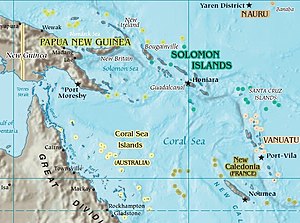Operation RY
| Operation RY | |
|---|---|

Map of the Coral Sea area with Nauru and Ocean (Banaba) islands in the top right corner.
|
|
| Planned | April 1942 |
| Objective | Occupation of Nauru and Ocean islands |
| Date | 10 May to 30 August 1942 |
| Executed by | Imperial Japanese Navy |
| Outcome | Postponed on 15 May 1942; completed successfully on 29–30 August 1942 |
| Casualties | 1 minelayer, 1 auxiliary ship sunk |
Operation RY was the Imperial Japanese plan to invade and occupy Nauru and Ocean islands in the south Pacific during the Pacific conflict of World War II. The operation was originally set to be executed in May 1942 immediately following Operation MO and before Operation MI, which resulted in the Battle of Midway. The primary reason for the operation was to exploit the islands' supplies of phosphate. After a postponement due to interference by enemy forces, the operation was completed in August 1942.
Before and during World War II, Nauru and Ocean Island were isolated but rich with phosphate deposits. The islands were under Australian mandate control, with the British Phosphate Commissioners (BPC) running the phosphate mining. The phosphate deposits were mined for making ammunition, explosives and fertilizers.
The German auxiliary cruisers Orion and Komet sank five merchant ships and bombarded the island causing damage to the phosphate mining, disrupting the Allied production of phosphate. Following the raids, the Australian Commonwealth Naval Board requested that the British Admiralty redeploy Australian naval units to meet the threat posed by raiders. The armed merchant cruiser HMAS Manoora arrived off Ocean Island on 4 January 1941, and Australian and New Zealand warships maintained a continual presence off the islands during the subsequent months. A naval company and two field guns were deployed to each island. The attacks also led to the introduction of convoys between Australia and New Zealand.
...
Wikipedia
